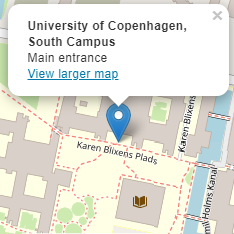Adam Gottlob Øhlenschlæger Hauch & Jeppe Smed Jensen
Et studie af etableringen af det efternavnetypologiske mellemnavn i Danmark i 1800-tallet
Lars-Jakob Harding Kællerød forsvarer sin ph.d.-afhandling.
Bedømmelsesudvalg
- Lektor Rikke Steenholt Olesen, formand (Københavns Universitet)
- Docent Katharina Leibring (Namnarkivet i Uppsala)
- Professor emeritus Tom Schmidt (Universitetet i Oslo)
Leder af forsvarshandlingen
- Michael Lerche Nielsen (Københavns Universitet)
Et antal eksemplarer af afhandlingen er fremlagt til gennemsyn og hjemlån i Det Kgl. Biblioteks information på Københavns Universitet Amager og til gennemsyn på Det Kgl. Biblioteks læsesal Øst, Diamanten samt på Institut for Nordiske Studier og Sprogvidenskab, Njalsgade 136.
I afhandlingen undersøges mellemnavnebrugen i Danmark i det 19. århundrede i forhold til en række geografiske og demografiske aspekter. Et mellemnavn defineres her som et efternavnetypologisk navn, der optræder mellem fornavn(e) og efternavnet i en onomastisk profil, dvs. et individs fulde navn. Datasættet omfatter alle navne, der er optegnet i den digitaliserede version af den danske folketælling fra 1880, hvori lidt under 2.000.000 individer er registeret. Da datasættet er omfattende og yderst heterogent præsenteret, er der igennem projektet etableret en systematisk metode, hvorved navnekomponenter via en kombination af mekaniske og manuelle processer kan identificeres typologisk. Der gives tillige et bud på en opstilling af principper for lemmatisering og kategorisering af mellemnavne i et historisk materiale. Studiet afdækker desuden hvilke mellemnavne, der er i brug i folketællingen, og hvordan de er anvendt. En række samfundsmæssige forandringer i det 19. århundrede kan have påvirket brugen af mellemnavne i perioden, og dette sættes i relation til individers identitet og identifikationsbehov.
This dissertation examines the use of middle names in 19th Century Denmark and how such usage relates to geography and demographics. Middle names are defined here as names that take the typology of a surname but appear between the first name(s) and the surname in the full name (onomastic profile) of an individual.
The data set comprises all names registered in the digitized version of the Danish census from 1880, pertaining to nearly 2,000,000 individuals. As the data are extensive and non-uniformly presented, a systematic method was established whereby name components can be typologically identified through a combination of mechanical and manual processes.
Thus, it has been possible to identify middle names, or the absence of middle names, in more than 98 % of the onomastic profiles listed in the census. Middle names are found in approximately 6.2 % of the registered names. The survey addresses the establishment of principles regarding the lemmatization and categorization of middle names.
Middle names have a long and varied history in Denmark, though until the 19th century their use was almost exclusively among the higher social classes. The relationship between the more widespread use of middle names and the profound societal upheavals during the 19th century required investigation. To examine this, three research questions have been posed: (1) what names are used as middle names in the census; (2) how are middle names used; and (3) are there indications of an established relationship between the use of middle names and individuals' sense of identity, the nature of which relationship can be expected to change over the course of the 19th century due to societal changes?
By considering these questions relative to a number of geographical and demographical aspects (such as gender and age), a thorough insight is provided into Danish usage of middle names during the 19th Century.

